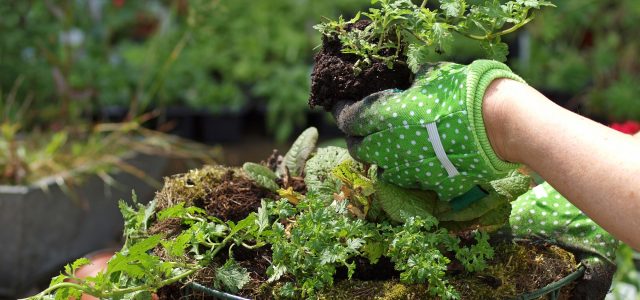
THE POTTED GARDEN:
HANGING BASKETS
Planting a hanging basket may be the ideal way to expand your garden or make the best use of the outside space that you have
If you plant your summer hanging basket at the beginning of July then it will thrive in a frost free environment producing a vibrant flourish of colour through to the autumn.
Choosing the right hanging basket really comes down to personal taste, but there are two basic styles to choose from – those with solid sides or the traditional wire types. The benefit of using wire hanging baskets is that they allow you to grow some plants through the sides rather than everything coming from the top of the basket. Whichever you choose, go for the biggest that you can – the more room you have for plants the better.
First, you need to prepare the compost and liner. For soil you can go for the easy option and pick a ready-made hanging basket compost or you can use a multi-purpose compost add a handful of perlite to improve drainage and aeration and add hydration crystals to help the soil retain water. Slow-release fertiliser granules can also be mixed in to feed the plants.
An open wire basket needs a liner to prevent compost falling through. Traditionally, moss is used and gives a natural feel, but other linings are just as good such as coconut fibre. Using a bucket or empty pot to steady the basket while you work, place moss around the bottom half, and then add newspaper as a barrier between the moss and compost. This will stop the soil from falling out initially, and as the paper rots the roots will grow through to hold the earth in place. Fill this bottom half with soil.
Next, insert the trailing plants by making holes 50mm (2in) apart at this level and poke the roots of the plants such as lobelias or trailing ivy through the sides so they lie on top of the compost. Add more compost and trailing plants, positioning them between those already planted below.
Now plant the top of the basket. A dramatic centrepiece is a must-have – something like an upright fuchsia or a geranium will give you a strong and vibrant focal point. Surround that with trailing plants like petunias or ivy-leafed geraniums, and one or two busy lizzies. Remember to leave a 30mm (1.5in) gap from the soil to the top of the basket to help it hold water.
Finally hang the basket. Water thoroughly as hydration is key – hanging baskets will dry out very quickly without regular – sometimes daily – watering. Fit the chain in place and suspend the basket on a secure, supporting bracket. Take time to rotate the basket so that its best side faces outwards.
JULY TIPS
If hanging baskets are just part of your outside space then here are some gardening tips for this month from the Royal Horticultural Society:
• Plant out seedlings and young plants
• Watering and weeding
• Start spraying roses to stop black spot and mildew
• Fast growing hedges will need a trim
• Plant hanging baskets and containers
• Plant salad leaves seeds
• Tie up climbers
• Feed spring bulbs for next year
• Plant out tomatoes
• Mow the lawn

